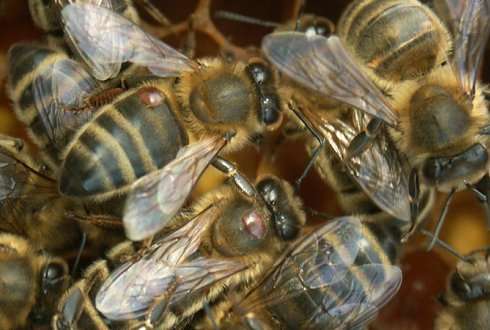Insecticide increases effect of varroa mite

Honeybees infected with the Varroa destructor mite have less stamina than those which have been effectively treated against the parasite. Additional exposure to the insecticide Imidacloprid further increases the harmful effect of the varroa mite. This was the conclusion of Wageningen UR scientists Lisa Blanken, Frank van Langevelde and Coby van Dooremalen as published in an article in the British Royal Society's magazine Proceedings B.
'Flight mill'
The scientists performed a unique experiment with various bee colonies. They captured worker bees returning to their colony with pollen at the hive opening and fitted a 'harness' to the top of their thorax. The bees were then attached to a smoothly running mill with a counterweight. "Imagine the bee version of a treadmill for horses," Van Dooremalen explains.
Combination of stressors
The bees flew circles in the mill while their flight speed and total distance were registered. Van Dooremalen: "This experiment showed that 'clean' bees – bees from colonies that had been treated against varroa – flew the fastest and farthest. Bees with a substantial varroa infection flew significantly shorter distances. Clean bees that were also given a realistic dose of Imidacloprid via sugar water in the colony flew as far and as fast as the control group. But when bees infected with varroa were given the same dose of Imidacloprid, they flew less far and for an even shorter time than bees that were only infected with varroa."
Debate
There has long been a debate about the effects on honeybees of Imidacloprid and other pesticides from the group of so-called neonicotinoids. Many of the experiments that show negative effects of these products on honeybees have been performed with a dose of pesticide far larger than bees would pick up in the wild, however. Van Dooremalen: "The bees in our experiment were fed with a weekly 660 ml of sugar water that contained six micrograms of Imidacloprid per litre. This is a realistic dose which could be picked up by bees in the field if they only forage on crops treated with the product."
Effect in the field
Now that the measurable effect of a neonicotinoid on the flight capacity of bees infected with varroa has been shown, the next step is to study the consequences thereof on a colony in the field. "A bee that cannot fly so far will bring less food to the colony," Van Dooremalen continues. "It is therefore conceivable that a colony with varroa, which is also exposed to neonicotinoids, starts the winter in poorer health than colonies not exposed to the insecticide, and thus experiences more deaths. Whether this effect actually occurs in practice needs to be investigated in follow-up research."
Fighting varroa
Jan Dommerholt, chairman of the Dutch Beekeepers Association, is very interested in the research performed by Van Dooremalen and her colleagues. "I am not necessarily surprised that an insecticide affects bees," says Dommerholt. "What is remarkable is that this is especially the case when it is combined with a varroa infection. I believe the research underlines how important it is to fight varroa mites in the right way."
The research was financed from the budget for Policy-oriented Research from the Dutch Ministry of Economic Affairs.
Provided by Wageningen University


















